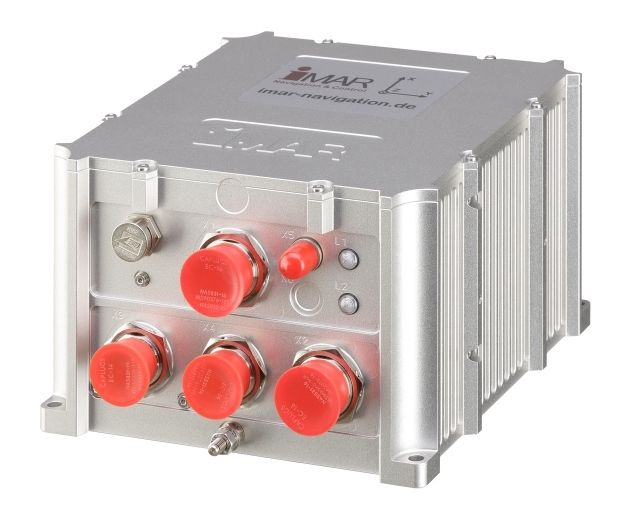iNAT-MSLG-5: MEMS Based Navigation, Surveying & Control System (5 °/h, 1'000 Hz)
Low Weight Small Size MEMS Based INS of class 1 °/h (filtered)
iNAT-MSLG-5 is a light weight accurate MEMS based INS of class 0.1 deg/hr (AllanVariance bias stability) and 5 deg/hr bias performace over full temperture range, consisting of 3 robust MEMS gyros and 3 MEMS servo accelerometer axes, integrated multi-constellation capable GNSS Receiver (GPS, GLONASS, GALILEO, BEIDOU etc.), wheel sensor interface and an advanced 42+ state Kalman filter based INS/GNSS loosly or tightly coupled data fusion.
The iNAT series is used for navigation, guidance and control of vehicles, stabilization of platforms, surveying reference as ground truth etc. in the fields of industrial, automotive, surveying, defense and space applications.
Features
- Applications: GNSS aided navigation(air, land, sea, subsea), attitude heading reference (AHRS), surveying, UAV, AUV and RPV guidance & control
- Real-time data output: longitude, latitude, alttude / height, velocty, roll, pitch, yaw / heading, angular rates, acceleration, status, calibrated raw data INS/GNSS (for post-processing)
- Dual-antenna GNSS capability to provide true heading also at standstill or during operations without sufficient motion dynamics
- integrated all-constellation / all frequencies GNSS receiver; dual antenna heading supported as option
- designd to operate also in GNSS denied, spoofing and jamming environment
- Interfaces: RS422 (UART), CANaero / ARINC825 / CAN, Ethernet (TCP/IP and UDP), ARINC429, SYNC-I/Os
- Data Output rate up to 500 Hz (each data log separately adjustable)
- The very low data output latency of 1 ms and the very low data output jitter of < 1 ms enables the iNAT-MSLG-5 also to be a reliable solution for steering & control of highly automated and autonomous driving vehicles
- Measurement range:
+/-480 deg/s, +/-15 g - Inertial Sensor Performance:
Heading accuracy:
< 0.05 deg (GNSS aided); 0.01 deg in post-processing (dependent on environment)
Attitude accuracy:
< 0.05 deg (GNSS aided)
Position accuracy GNSS aided < 2 m (rms) [S/A off]
Position accuracy GNSS aided 0.02 m (rms) [RTK available]
Noise / ARW / VRW:
0.1 deg/sqrt(hr) / 100 µg/sqrt(Hz)
Bias stability (AV):
< 0.1 °/hr, 0.05 mg @ const. temp. - Integrated 42+ state tightly or loosly coupled data fusion
- Internally up to 32 GByte non-volatile memory for data storage
- Connectors: MIL-C-38999 III type and TNC
- Power Supply: 10...34 V DC, 20 W
- Weight: approx. 5'100 grams
- Power supply and EMI-EMC protection qualified to MIL-STD-704F / MIL-STD-461G / MIL-STD-810G / DO160G
- Modular system architecture: customized applications can be integrated by iMAR easily (please contact our sales for details). So the iNAT can provide arbitrary data and command protocols according to customer requirement, e.g. to substitute other navigation systems as FFF by iNAT (Form-Fit-Function replacements)
- iNAT-MSLG-5 is not subject of any export control or ITAR regulations
Note:
In compliance with our proven design philosophy and our technical code of conduct for development, production, and quality assurance of our products and solutions, only physics determines the behavior of iMAR’s measurement systems. The real-time output of our systems and solutions in the inertial signal path is achieved through the intelligent signal processing developed by our experienced engineers – not by artificial intelligence (AI).
Why?
We cannot recommend that integrators or users entrust the success of critical or general missions in inertial navigation, stabilization or control to the heuristic decisions of AI.
Rely on the high reliability, accuracy, and availability of iMAR solutions, as well as on the leading INS/GNSS/+ expertise and experience of our engineering team in Germany. This is based on our mathematically and physically precise algorithms, traceable results, our sensor, hardware, and algorithm design, and our production facilities, which are certified to military and aviation standards.
Note: We apply AI methods in signal processing where they provide benefits for the application (e.g., for improving image or scenario analysis). However, our highest priority is mission safety – even in so-called corner cases of applications, where AI is typically not sufficiently trained.
Further information
More manuals, user reports and other information in our download area.


